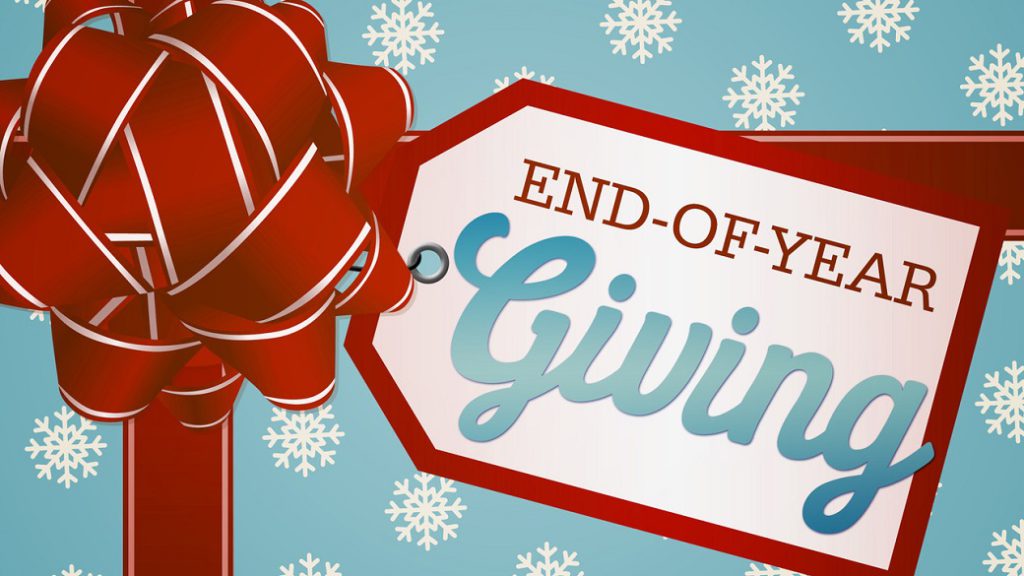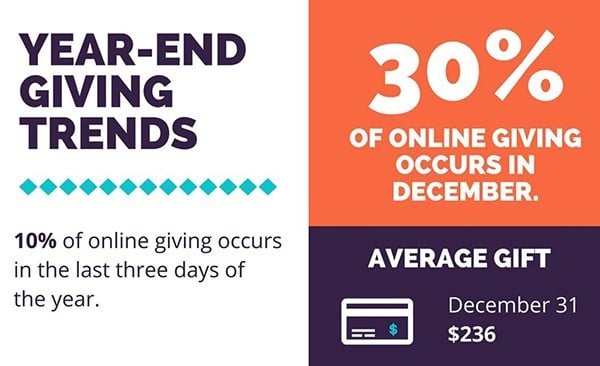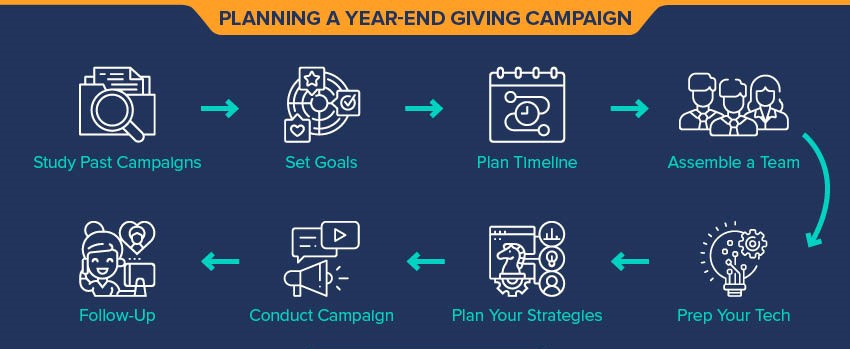
The kids are running around, playing backyard games on a hot Summer day. Your toes are deep in the beach (although, try as you might, you can’t hear waves crashing — your tootsies are merely buried in your sandbox). You’re sipping from a cool pitcher of lemonade (or something stronger, if it suits your tastes). The only thoughts in your mind are that of complete and utter……relaxaaaaaaaation…….
Well, snap out of it. Because it’s time to start thinking about your organization’s year-end giving!
Way too early to think about THAT, you say? We beg to differ.

THE SIGNIFICANCE OF YEAR-END GIVING
It’s a known fact that the generosity inherent with the Holiday season prompts donors to give more than at any other time on the calendar. Furthermore, many annual and sustaining donors have built December charitable gifts into their routine — especially for individuals and corporations with tax ramifications foremost in their minds. And after two COVID-plagued years that have turned fundraising upside-down for many nonprofits, the stakes for 2022 are as high as any time in recent memory.
This dynamic is so prevalent that half of all nonprofits say they receive 50-65% of the year’s total revenues during the last three months of the calendar year — with December accounting for 30% of the year’s donations (and December’s final three days up to 10% of annual revenues). The market for financial support is flooded with opportunity during this time, and leveraging it to your organization’s benefit requires a solid year-end giving strategy — one that is involves multiple touch points but streamlined into a single campaign theme — well in advance, backed by quantifiable, evidence-based data that supports your most important asset: the story of how donors’ support allows you to help the populations you serve.
ISN’T IT A BIT TOO EARLY TO BE THINKING ABOUT DECEMBER?
How many times have you heard ‘wow these kids grow up in the blink of an eye’ or ‘the summer went by just like that (finger snap)?’ The frequency with which the phrases are uttered proves how quickly four months can fly by.
The most impactful year-end appeals share a key attribute: they are a result of meticulous preparation. If you remember the year-end giving statistics we noted above, you know it’s critical to take ample time to develop a rock-solid strategy. And from a competitive standpoint, know that the number of nonprofit organizations in the U.S. has increased +34% between 1998 and 2015, to nearly 1.6 million….and they are starting to plan earlier than ever. With all this evidence underscoring the intense competition for philanthropic dollars, it makes sense to get your plan going so you can carve out an effective strategy, troubleshoot it as you plan, and get in front of any obstacles that may present themselves.

NOT SURE WHAT YOUR CAMPAIGN SHOULD FOCUS ON?
Look at the data from your past year-end campaigns to get an idea of which approaches worked and which lacked the punch to give you the desired results. Keep in mind the objective is not simply to make the ask; that strategy typically delivers some of the lower conversion rates among campaigns. Rather, your goal is also to give your audience a compelling REASON to donate to your cause. Which STORIES has your audience found most meaningful? Most relatable? Make sure these four things are part of your plan:
- Clear identification of a BENEFICIARY of your cause’s support
- The specific CHALLENGES AND DEFICIENCIES they face — what support they need most critically
- Communicate the FUNDRAISING GOAL you have set
- Clearly demonstrate the IMPACT that reaching your goal would have — how would your beneficiaries’ lives improve as a result
MAKE IT EFFORTLESS FOR DONORS TO GIVE
Offering your audience a myriad of ways to make their gift will only increase the reach of your potential donor pool — especially across generations, as a 65 year-old will likely give in a different manner than a 25 year-old. Making several donation channels available will allow your prospects to choose the option they find easiest. Donations online, by phone, in person, by mail, or by text (especially popular with the younger demographic) round out the main avenues to have you covered.
Then, consider diving deeper into more personally meaningful ways people can donate: tribute gifts to honor a loved one, legacy gifts to remember the charity in a will/estate, and security/investment or real estate gifts. Finally, offer donors the option of one-time, pledge or recurring giving (monthly, quarterly, annually) in an effort to extend the relationship.
PUT A TIMELINE TO YOUR PLAN
Create a ‘fundraising/marketing flowchart’ for your organization and leave a line item for ‘Year-End Planning & Campaign.’ Then, start plotting action items (a few examples are below) into your flowchart to give you an idea of what needs to be done when:
- Past campaign analyses, brainstorming and planning with staff (and Board of Directors if you have one)
- Finalizing your approach, story, need statement and impact
- Framing the channels you’ll use (direct mail, email, digital, social media, video, outdoor, etc.) and accompanying budget
- Segmenting your donor lists to best serve your campaign (always paying extra-special attention to your top and most loyal donors)
- Plot your communications tactics (leaving ample time for revisions), including capitalizing on Giving Tuesday (always the Tuesday after Thanksgiving) and a ‘last-minute push’ for gifts in the final three days
- Activate a timely and robust acknowledgement/thank-you plan immediately after each donation, and additionally to the entire donor group accompanied by fundraising results upon the conclusion of the campaign

CONSIDER CREATIVE IDEAS TO MAXIMIZE IMPACT
In planning conversations with your staff and board, you may discover some out-of-the-box thinking that has shown to increase giving to nonprofits. Here are some ideas you may want to consider for your year-end campaign:
- Adding a tangible value to communicate how much support is needed (such as the Greater Cleveland Food Bank‘s ‘Every dollar raised provides four meals’ message)
- Communicate the overall FUNDRAISING GOAL….and consider amortizing a gift-per-donor message to increase your donor pool (think Wikipedia‘s ‘If everyone reading this contributed just $4 our fundraiser would be over in minutes’)
- Leverage new or existing partnerships to boost your fundraising efforts — could include fellow nonprofits, a corporate partner, or even local celebrities/social media influencers who may want to help
- Integrate a matching program, courtesy of a business, foundational or individual/board supporter (one University of Chicago study found individuals are 22% more likely to donate when an offer to match their donation is extended)
BE SURE TO GATHER CRITICAL DATA
Like all things nowadays, a solid year-end giving plan must be rooted in data. Many nonprofit performance metrics are available to give you an accurate picture of what went right, what went wrong, and where your strengths and areas of improvement lie. Some obligatory indicators to measure include:
- Revenue raised
- Number of gifts
- Average gift amount
- Conversion rate (percentage of total who donated)
- Percentage that were new donors
- Percentage that were 2-year+ / 3-year+ / 5-year+ donors
- Donor retention rate (percentage of total that were previous donors)
- ROI (amount raised for every dollar spent)
If you have a few minutes we’d love to learn more about your needs and how we can help you get the most out of your year-end giving plan. Please reach out to us for a quick conversation!
